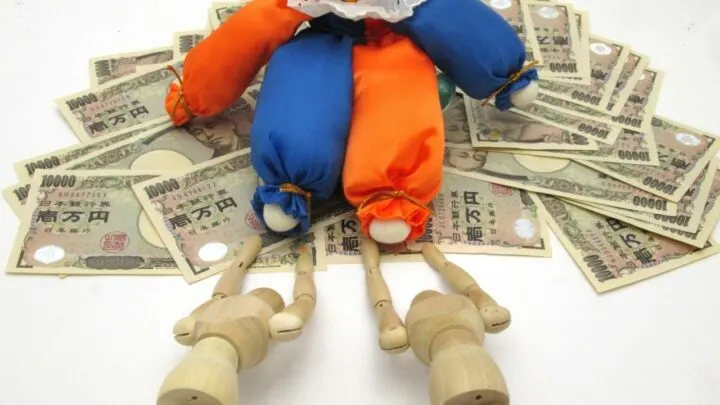Let’s take a look at one of the more distinctive physical acts many people recognize from Japanese culture: dogeza.
While the term itself is probably unfamiliar, you’re probably at least passingly familiar with its meaning, that of prostrating yourself on the ground, in an extreme form of bowing.
In this article, we’ll cover the full meaning of the word, how dogeza works, and its actual place in Japanese culture, past and present.
But first, let’s have a quick overview of the term dogeza.
What is the meaning of dogeza?
Dogeza is an action performed in Japanese culture where you kneel on the ground and place your hands and forehead on the ground. It is used to express a deep sense of apology. While common in Japanese media, it is not very common in real life.
The word dogeza in more detail
Dogeza, as it’s written is a very simple, straightforward word (at least as far as Japanese words go). It’s simply 土下座. Let me explain by breaking down those three characters.
The first one, 土, simply means “ground” or “soil.” The second character, 下, means “down, below, descend, inferior.” And the last one, 座, means to “sit, seat, squat.”
So, putting that all together, we get a perfectly descriptive word meaning “sitting down on the ground.”
Of course, that doesn’t quite capture the gravity of what dogeza is, but it does draw a decent picture. Enough to remember it effortlessly.
Dogeza could also be written in kana as どげざ.
How is dogeza performed?
When you want to perform dogeza you need to lower yourself to your knees and bend over at the waist. Then you place your hands flat on the ground and lower your forehead to the ground.
To really express your regret, you’ll want to make sure your head is literally touching the floor.
What is the significance of dogeza?
The idea behind dogeza is that you want to apologize for something in the most intense way possible.
It’s an act of begging for forgiveness, of showing total surrender for your bad actions.
By lowering yourself to the ground in the dogeza way you’ve achieved a few things.
First, you’ve humiliated yourself. You’re literally down on the ground where people and animals walk with their dirty feet.
When you consider how carefully Japan tries to cordon off its different types of floors in the name of cleanliness, you get a sense of how intense this can be (e.g. in a single hotel, I once ended up wearing at least four or five different sets of footwear during my stay).
Second, you’ve placed yourself at the other person’s mercy. You are completely helpless when you’re down there. Your eyes are averted too, so you couldn’t even see a threat if one came your way.
You have completely given yourself over to the person or persons you’re apologizing to.
Finally, it puts you in a position where the other person can very clearly choose to relieve you of your position or not. They can ask you to stand, or simply leave the room. Or kick you. Dealer’s choice.
But, basically, you’ve wholly removed yourself and your ego from the equation, and in doing so made your regret as known as possible. Well, at least in theory.
Dogeza in Japanese life
Dogeza probably has its origins from well before recorded Japanese history. Some sources say they picked up the practice from the Chinese at the time, others suggest that it was already in use when they began communicating and trading with the Chinese.
For centuries dogeza was an important part of life, and a good way of keeping your head if you came to cross a person of higher rank than you.
Nowadays, dogeza has become much less common in real life.
To be sure, you’ll see dogeza featured in television dramas, anime, and manga all the time. But this is because of the fact that dogeza is so rare and deeply dramatic.
In everyday life, dogeza is saved only for the most grave of situations. For example, back in 2016, there was a terrible bus accident that killed fifteen people.
The president of the company (along with a couple other ranking members) got down into dogeza to apologize in front of television cameras.
This is the sort of situation you’ll see dogeza in today. Usually politicians and corporate leaders apologizing in front of large groups of people (or even the whole nation) for their wrongdoing.
This has also had the effect of changing Japanese public perception of dogeza, even going so far as to dilute its significance down to almost nothing.
Many people in Japan now feel like dogeza has no significance due to overuse by politicians and companies.
That said, you’ll still see it in common life every once in a while.
Dogeza has been spotted in the wild, often with boyfriends apologizing to girlfriends, or drunk friends sorting out some interpersonal issue.
But even here it’s looked at as quite a strange thing.
And yet, as is the case with humans everywhere, some people like to abuse a good thing. A couple of people have been arrested for forcing others into dogeza.
That’s right!
There have been a few incidents that I could find where a disgruntled customer forced an employee (in one case a convenience store worker, in another a department store employee) to perform dogeza to apologize for a trivial issue.
Some people just like to humiliate others, I guess.
Don’t confuse dogeza with other forms of bowing
Some foreigners confuse dogeza with seated bowing. To be clear, they are two very, very different things.
As a lot of traditional Japanese life is conducted while sitting on the floor, they have a system for bowing while seated.
The one most commonly mistaken for dogeza is the seated saikeirei which, frankly, does look a lot like dogeza.
However, saikeirei looks far more dignified, the butt stays lowered towards the feet, at the head does not touch the ground.
Saikeirei is fairly common, and is merely a way of showing deep respect.
This also goes for the seated futsurei which look like the saikeirei, just without bending down quite as deep.
”Dogeza” in other cultures
Let’s not overstate things, though. Acts very similar to dogeza exist, and have existed, in other cultures for as far back as we can recall.
In fact, the Japanese may have gotten the practice from the Chinese act we know as “kowtow.”
In European culture, it’s not uncommon to read stories of people getting down on hands and knees to beg forgiveness of a member of royalty.
And we can read similar acts in Middle Eastern culture even if we look in the Bible.
Japan has somewhat codified the act of dogeza a bit more strictly than other cultures, but it’s a fairly human response that anyone can understand.
It’s a strong, dramatic act that should be reserved only for the most desperately serious of situations.

“I’ve lived in Japan on-and-off for the last five years, travelling to (almost) every corner of the Land of the Rising sun. I’ve deepened my love of the language with big hauls from Sapporo book stores, by chatting in Shinjuku coffee shops, drinking in Osaka “snack bars,” exploring distant Okinawan islands, and hitching rides with monks in Aomori. Japanese is a wide and deep language, and I’m always eager to dive in deeper.”

